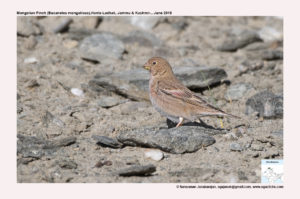Mongolian Finch

Mongolian Finch Eremopsaltria mongolica
Etymology:
- Eremopsaltria : Greek word eremia- desert; psaltria –female lyreplayer, Singer
- Mongolica : From Mongolia
Distribution in India: Resident of Ladhak (Hanle) in India.
Description: Size of 14–15 cm; Wt. of 18–26 g. It is a medium-sized, stocky, large-headed and blunt-billed, long-winged pale finch with notched tail. The male has forehead to nape as pale grey-brown, streaked finely darker and may show pink tinge on side of forehead. The side of neck is pale buffish-brown or buffish-sandy; upperparts are like nape or slightly greyer, and indistinctly streaked darker, rump is pale sand-brown, tinged in pink, uppertail-coverts are sand-brown, tipped grey-brown; lores are dull buff to sandy, paler and narrow supercilium fading over light sandy-brown ear-coverts; narrow pale buff or greyish-white eyering; cheek to sides of chin and upper throat are pale sandy, washed pink; tail is black or blackish-brown, broadly edged whitish on outer feathers. The median upperwing-coverts are like scapulars, tipped pale pink, greater coverts are blackish, broadly edged whitish or deep pink on outers, alula, primary coverts and flight-feathers are black, edged pale pink on primary coverts and primaries and whitish on inner secondaries forming contrasting pale panel on closed wing. The primaries are finely tipped pale or whitish-buff, tertials are dark brown, edged whitish; below, deep rose-pink in fresh plumage on side of breast and flanks, whitish on belly to undertail-coverts; in worn plumage its paler and more uniformly grey-brown, with less pink on rump and in wing The bases of flight-feathers are buffish-brown and fringes of tail whiter, side of breast and flanks are pale grey with pink or pale pink wash; iris is dark brown or black; bill is greyish-yellow, paler base of lower mandible; legs are brown or pale brown. The female is like late-summer male, but more uniformly buffish-brown on upperparts to rump and uppertail-coverts, greater coverts edged white at base, tipped light pink, secondaries are edged pale or whitish-buff and edges of primaries narrowly pale pink; may show faint tinge of pink on lores to cheek; underparts are pale whitish-grey, often washed or finely streaked sandy-buff on flanks; bill is pale yellow. The juvenile is browner or more sandy brown than female and lacks pink, lightly streaked browner on crown, nape and upperparts, upperwing-coverts fringed bright sandy brown and flight-feathers are edged pale buff-brown to whitish-buff forming short pale wingbar on closed wing, tips of flight-feathers are fringed sandy or pale sandy buff, tertials broadly edged pale brown and tipped paler, underparts are buff-brown, paler on belly to undertail, bill is brown or dull yellowish-brown.
Habitat: It is found in montane and submontane, arid, desolate and semi-desert areas with slopes, cliffs, screes, ravines and steep valleys, also open stony, sandy areas with grassy patches or low scrub, edge of alpine meadows and cultivated fields. It is found from 1500m –4500 m. In non-breeding season it is found in similar habitat at lower altitude 1500–3000 m.
Food habits: It eats small seeds, buds and shoots, like saltwort, wormwood), grasses and sedges. The nestling diet is mostly green seeds. It forages on ground, around or beneath low vegetation, usually hopping in horizontal position; picks seeds from bent-over seed heads and extracts seeds from cattle dung. It is tame and often confiding. It is found singly, in pairs and in small flocks. In non-breeding season and early summer it is more social, and occurs in larger groups often in same-age or single-sex flocks. It makes regular dawn and dusk flights over some distance in search of water; often forages at good distance from nest-site.
Breeding habits: They breed in Apr –Aug in Ladhak- India , South Caucasus and North East Iran. They lay two broods. They are monogamous, solitary and semi-colonial. The pair formation takes place in winter flocks or during spring passage. The male performs song flight; displaying male on ground, with plumage sleeked down and crown ruffled, leans towards female; same posture adopted by partners for bill-touching; some do courtship feeding . the nest is built by female. The nest is a loose foundation of twigs, plant stalks, down and fibers, leaves, grass and animal hair, placed in shallow saucer or depression on ground, under low bush or grass tussock, in scree slope, between rocks or boulders, in crevice or niche in cliff or rock face, or in wall of building, well or ruin. They lay a clutch of 4–6 eggs. The incubation is done by both sexes. The chicks are fed and cared for by both parents. The nestling period is 18 days. The young are independent 12–17 days after fledging.